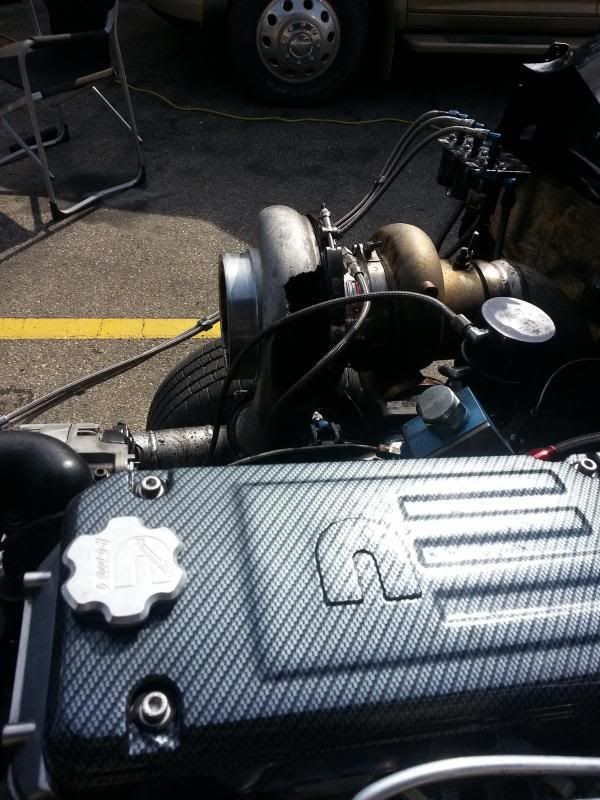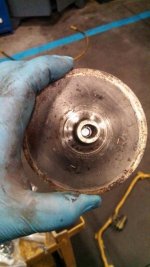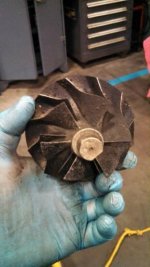You are using an out of date browser. It may not display this or other websites correctly.
You should upgrade or use an alternative browser.
You should upgrade or use an alternative browser.
Turbo Wheel Lightening
- Thread starter Drothgeb
- Start date
BramanteCummins
ADD maniac
- Joined
- Nov 1, 2012
- Messages
- 636
that is a pretty gnarly picture of epic turbo failure. definitely don't want to be standing right there when that happens.
that is an awful expensive turbo to be trashing.
better you than me. keep us posted
I got it at low cost, should be interesting to say the least!
Drothgeb
Almost Fast-N-Loud
- Joined
- Sep 18, 2010
- Messages
- 820
And.....
One of the things that the manufacturers R&D plan for, is wheel failures. So their housings are designed to contain the parts in the event of a failure. With that being said, if you're using OEM housing you should be OK, just don't try this on a Chinese clone. I'd make sure that you have the cross bars in the exhaust too.
Personally, I wouldn't do this on a high pressure single, they're already pretty stressed. But I'm not too worried about doing it on a low pressure primary, where it's going to be well within the map.
This was original unmodified Garrett GTA4702
Borg/Warner put out a video a while back, where they ran a turbo to failure, and the cover held. Their point was.... that's why you buy a Borg turbo instead of a chinese clone. Supposedly, they use a higher quality material, and they're safer in the event of a catostrophic failure. Maybe the engineers at Garrett should talk to the ones at Borg.
I had a secondary fail a couple of years ago when a coupling blew at 100psi. While parts came out the outlet, none came through the cover.
Pretty good chance in the Garrett's case, and my case, they were well outside the map.
Last edited:
nwpadmax
Turbo Geek
- Joined
- Nov 22, 2006
- Messages
- 3,128
Droth, if you think BW covers never fail, you are fooling yourself.
All the big 3 OEMs do burst & containment testing, and I'm sure there are examples of every brand that have failed.
There is also a fundamental reason why covers can fail when used outside the design envelope for long periods of time.....anyone want to hazard a guess? This is a quiz.
All the big 3 OEMs do burst & containment testing, and I'm sure there are examples of every brand that have failed.
There is also a fundamental reason why covers can fail when used outside the design envelope for long periods of time.....anyone want to hazard a guess? This is a quiz.
Last edited:
Pony_Kegger
New member
- Joined
- Jul 16, 2009
- Messages
- 369
Work hardening of the cover from excessive compressor outlet temps and pressures making it brittle.
BramanteCummins
ADD maniac
- Joined
- Nov 1, 2012
- Messages
- 636
Close, but it's not work hardening per se.
Material fatigue
nwpadmax
Turbo Geek
- Joined
- Nov 22, 2006
- Messages
- 3,128
Material fatigue
That would be a possibility but not likely since this is a lightly loaded part (until something hits it of course).
Go simpler.
Pony_Kegger
New member
- Joined
- Jul 16, 2009
- Messages
- 369
Solution treatment, quenching and aging.
Are you after the aging part. Heat accelerates this process.
Old over worked turbos have seen alot of this long term high heat.
Are you after the aging part. Heat accelerates this process.
Old over worked turbos have seen alot of this long term high heat.
Last edited:
nwpadmax
Turbo Geek
- Joined
- Nov 22, 2006
- Messages
- 3,128
Solution treatment, quenching and aging.
Perfect. Now what happens when you age the living crap out of most aluminum alloys....?
Pony_Kegger
New member
- Joined
- Jul 16, 2009
- Messages
- 369
Hard as a rock and very brittle, with large inpurities.
nwpadmax
Turbo Geek
- Joined
- Nov 22, 2006
- Messages
- 3,128
Hard as a rock and very brittle, with large inpurities.
You're thinking correctly, but the details of it are this: it's a fine dispersion of small precipitates that give the alloy its strength and ductility. After lengthy aging, the fine precipitates that were your friends coarsen into much larger precipitates that are your enemies. This is very hard / impossible to avoid in most Al alloys above a certain temperature.
Don't think of the precipitates as impurities, the alloying agent was added for this very reason and the precipitates would not form without it. Recall that pure aluminum is damn near worthless for mechanical parts.
In an OEM app there are well known maxiumum compressor outlet temps that keep this process to a minimum. However, then you go out and compete with it and add 200F to the service temp and you see how it stacks up. Plus, a lot of folks buy used turbos with no idea how they were treated or how many millions of cycles it had on it before it went on their race truck.
Lastly, the GTA4702 shown above has a boreless compressor wheel that is not intended for competition use (read: not very abuse tolerant).
dvst8r
Unobtainium
- Joined
- Feb 16, 2008
- Messages
- 2,053
This whole idea just seem like disaster waiting to happen, whether done on cdm turbos or the best of the best.
We over-sped a Precision ProMod Gen II at Edmonton this year, here is a picture of the outcome:

The piece that is missing went right through the hood, it was about 2" wide and about 6 inches long. We still have the piece (one of the track crew found it) but I neglected to take a picture at that time.
We over-sped a Precision ProMod Gen II at Edmonton this year, here is a picture of the outcome:

The piece that is missing went right through the hood, it was about 2" wide and about 6 inches long. We still have the piece (one of the track crew found it) but I neglected to take a picture at that time.
Ghostman
24v crazy
- Joined
- Aug 24, 2012
- Messages
- 2,819
I thought boreless compressor wheels were developed to strengthen the hub area of the wheel to reduce fatigue due to load/unload driving style, like a stop and go etc. In essence, they should be more resistant to cracking and failure, etc. compared to a bored wheel.
nwpadmax
Turbo Geek
- Joined
- Nov 22, 2006
- Messages
- 3,128
I thought boreless compressor wheels were developed to strengthen the hub area of the wheel to reduce fatigue due to load/unload driving style, like a stop and go etc. In essence, they should be more resistant to cracking and failure, etc. compared to a bored wheel.
Their main function was to withstand low cycle fatigue (like you mention, repeated on-off cycling). And that, they do fine. The problem for hi-po applications is the joint design and the lack of support on the nose with no steel quill supporting it. I think I've said it before, stay within the design speeds and boreless works as advertised. Take it outside the design conditions and it fails for reasons other than low cycle fatigue.
Make sense? It transitions from one failure mode to another when you cross the line.
Ghostman
24v crazy
- Joined
- Aug 24, 2012
- Messages
- 2,819
Their main function was to withstand low cycle fatigue (like you mention, repeated on-off cycling). And that, they do fine. The problem for hi-po applications is the joint design and the lack of support on the nose with no steel quill supporting it. I think I've said it before, stay within the design speeds and boreless works as advertised. Take it outside the design conditions and it fails for reasons other than low cycle fatigue.
Make sense? It transitions from one failure mode to another when you cross the line.
Gotcha, yeah that makes sense. Thanks.
DIESEL_POWER
NGM Diesel
- Joined
- Jul 8, 2006
- Messages
- 5,178
This whole idea just seem like disaster waiting to happen, whether done on cdm turbos or the best of the best.
We over-sped a Precision ProMod Gen II at Edmonton this year, here is a picture of the outcome:

The piece that is missing went right through the hood, it was about 2" wide and about 6 inches long. We still have the piece (one of the track crew found it) but I neglected to take a picture at that time.
Sorry no surprise here, but over the last 3 years precision has had more failures than any other brand i can think of......NHRA, ADRL pro mod especially....Not sure why but its true.
Last edited:
biggy238
Well-known member
- Joined
- Aug 3, 2008
- Messages
- 11,123
Why does cat favor the boreless GTA structure over GT? Durability, production cost, tamper resistance?
I found this in a core this morning.
Should be a GTA 55 from a 2WS 3406E
From my Not-So-Smart phone
I found this in a core this morning.
Should be a GTA 55 from a 2WS 3406E
From my Not-So-Smart phone
Attachments
Smokem
Turbler
- Joined
- May 10, 2006
- Messages
- 5,565
Sorry no surprise here, but over the last 3 years precision has had more failures than any other brand i can think of. Not sure why but its true.
There is a 69 page thread about why on Yellow Bullet.
biggy238
Well-known member
- Joined
- Aug 3, 2008
- Messages
- 11,123
There is a 69 page thread about why on Yellow Bullet.
No proof without link.
From my Not-So-Smart phone


